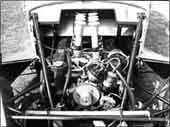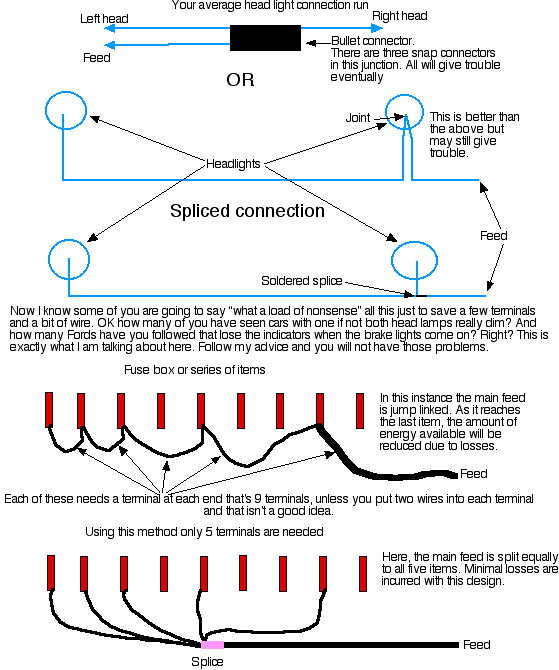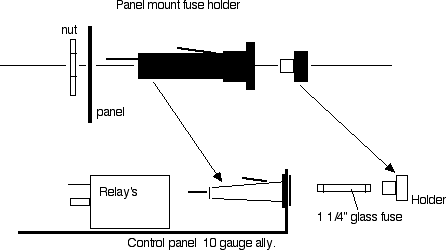TERMINALS - HOW AND WHERE TO USE THEM
By Geoff Kremer

Wrap a bit of wire round that screw it’ll be ok! Well that might be all right for your average manufacturer and bodger but we take our cars seriously. Only the best will do....am I right or what?
More breakdowns are caused by by poor electrical connections than anything else. Fact.
You can save money by doing things properly first time. Fact.
All “friction fit “ terminals will eventually cause trouble. By friction fit I mean “push on” terminals like spade and bullet one’s.
So to keep things reliable, keep these connection methods to an absolute minimum, and all other connections should be soldered. In the good old days, connections were by means of eyelet and screw or terminal posts. If you ever get a chance to get a close look at a pre 50’s Rolls, Bentley or Jag and a lot of the American cars, you’ll see what I mean. But that was when cars were made properly, in my view.
Your average manufacturer saves a lot of time and money by running wires back and forth so as to pick up on the nearest crimped terminal because the wire is so much cheaper than the labour involved in using a splice within the harness. What I am advocating is; that you run a wire, and where it needs splitting to feed another one, make the join right there, in the harness. An example is head lamp feeds where there is one say, “HI beam” feed that needs to be run to two headlights. I would run a wire from the source,eg dip switch, too, say the right head lamp and introduce a splice near that point to feed the left headlamp. We’ve just cut the terminal count by 30% on that run alone.
When you are hooking up a fuse box or series of switches, often you will need to supply many items with one feed. Normally one would loop the feed from one item to another, a better way is to splice the feeds within the loom, this reduces the terminal count, reduces losses and finally looks better. OK, I know once you’ve done all the wiring it’ll never be seen again, you hope, but there’s nothing like knowing you’ve done it right!

FUSES
There are many types of fuses available to use and I’ll run through each one.
- Glass tube. Car versions are usually 1/14” long and the electronics industry use 40mm versions.
- Ceramic or continental style. These are an open fuse and can give real problems especially in exposed locations.
- Spade or Blade style. These are now the accepted type of fuse to use and come in three sizes.
- MCB or Mechanical Circuit Breakers. These are manually reset able over load devices and not strictly a fuse. They are a bit of a luxury and are rather expensive.
- Thermal fuses. These are a bit like the MCB except that they reset themselves automatically. Many car manufactures use them as overload protection for electric window lifts and electric door locks. They can burn out or refuse to reset, then you have to replace it.
SPECIFICATIONS.
Fuses are designed to rupture and disconnect the supply when a set current is exceeded. The rupture current is usually 100% more than the stated rating so a fuse rated at 8 Amps will rupture at 16 Amps.
Choosing the correct fuse rating is important.
A WORD OF WARNING.
NEVER EVER WRAP WIRE, SILVER FOIL OR USE A NAIL TO REPLACE A FUSE!
Too smaller rating, and the fuse will overheat and possibly burn. To large, and it won’t protect, in this case the likely event will be that the wiring will burn out. Having said that, It’s probably wiser to aim slightly high rather than low in your choice of fuse.
Another thing to consider is that a lot of items will take quite a bit more current when first switched on, called switch on surge funnily enough! So that’s another thing to take into account, you should add about 20% to your measured or worked out figure.
So how do you work out the correct fuse rating?
Well, you can put a good quality ammeter in place of the fuse, switch the circuit on and read off the current, add 20% then use the nearest higher value available.
Or you could work the rating out mathematically Thus; Watts divided by Volts gives Amps. The voltage we know 12 Volts. So a bulb rated at 50 Watts = 4.1 Amps. + Allow about 20% for switch on surges .82 Amp = 4.92 Amps. Nearest fuse would be a 5 Amp Blade fuse.
50 divided by 12 = 4.1, 20% of 4.1 = .82 plus 4.1 = 4.92.
To give you an actual instance. Sides lights inc., number plate.
Bulbs are 5 Watts each. 4x sides plus 2 number plate. = 30 Watts.
30 Watts at 12 volts = 2.5 Amps + 20% (.5) = 3 Amps. Nearest fuse is an exact 3 Amps.
FUSE HOLDERS
Most Rods will only ever need about 13 circuits to be fused;
- Head lamps HI 130 w 15 amp fuse
- Head lamps Lo 100 w 10 amp fuse
- Sides Left & number plate 3 amp fuse
- Sides Right and dash lights 3 amp fuse
- Wiper/Washer 15 amp fuse
- Indicators 5 amp fuse
- Hazard lights/ interior/ boot (trunk) lights 7.5 amp fuse
- Horn 15 amp fuse
- Instruments/ heater fan 7.5 amp fuse
- Stop lights 5 amp fuse
- Reverse lights 5 amp fuse
- Rear fog lights (if forced!) 3 amp fuse
- Engine cooling fan 15 amp fuse
The above fuse ratings are a guide only and dependent on the exact wattage of the items used.
Of course if you have other items such as electric window lifts, door locks and the like, extra fuses will have to be added.
For a new wiring installation I would use a commercially available “block fuse holder”. These are very easy to use and contain sets of fuses ranging from 4 to 21 ways. I would not recommend using the fuse box from a manufacturers car, they are designed for their purpose only, not ours!
And now for something a little different.
Panel mount fuses.
As you may know I tend to buck the trend in almost all areas of Rod building and electrics is not ignored. A lot of the Rods, and shall I say “other cars”, that I’ve had the pleasure to wire, I have built a little control panel for them that use electronic style fuse holders. These have the advantage that you can have as many fuses as you like, you can easily add extras ones later and should one or more holders get damaged you can replace them individually. Another advantage is that the panel can incorporate all the relays
etc...so all the electrical control and safety items are in one place. I shall be covering this method later.

Tech Section
| 
